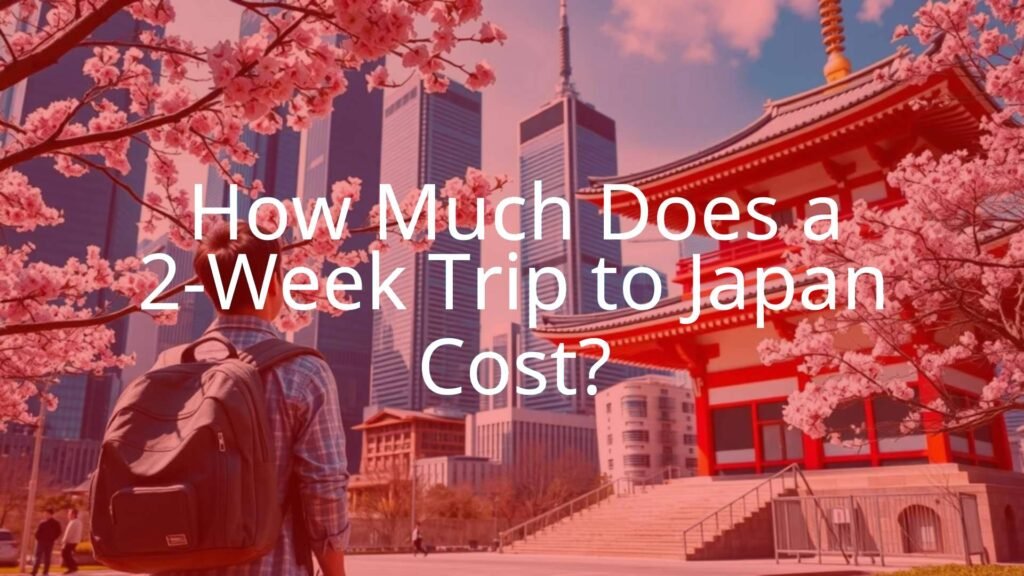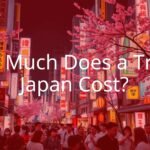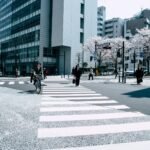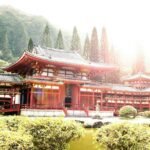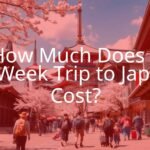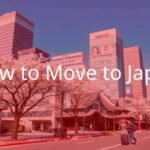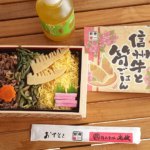Japan is famous for its historic temples, modern cities, and amazing food. Many people believe a trip here is extremely expensive, but it can actually be as affordable as visiting places in Western Europe or North America. A two-week trip for a mid-range traveler might cost between $2,000 and $5,000 per person, not counting your flights to and from Japan. Of course, your final cost depends on your travel choices, when you go, and your spending habits. With some planning, a wonderful two-week tour of Japan is absolutely doable.
This guide breaks down what you can expect to spend during two weeks in Japan-including hotels, transport, meals, attractions, and more. We’ll show you how different choices affect your budget, whether you prefer fancy hotels or hostels, high-speed trains or buses. Let’s take a closer look at what it costs to visit Japan for two weeks.

Total Cost for 2 Weeks in Japan
Average Trip Cost
The price of a two-week trip to Japan depends a lot on how you like to travel. One person alone spends about $2,099 for two weeks; a couple can expect to spend about $4,198 together. These numbers include hotels, food, trains and buses, and attractions, but do NOT include the price of getting to Japan.
These are estimates:
- Budget travelers: Stay in hostels, eat street food, and use local transport. About $59 per day, per person.
- Mid-range travelers: Choose comfortable hotels and a mix of restaurants, and visit museums. About $150 per day, per person.
- Luxury travelers: Stay in upscale hotels, eat at fine restaurants, and take private tours. Easily $380 per day or more, per person.
Japan offers something for every travel style and budget, so you can adjust your plans to fit what you’re comfortable spending.
Where Your Money Goes Each Day
On average, travelers spend about:
- $124 per day on hotels
- $52 per day on food
- $19 per day on transportation within cities
Activities and entertainment add about $20 per person per day. Going out at night or drinking alcohol adds around $16 more.
If you’re careful, it’s not hard to stay below these averages-especially if you skip expensive meals and don’t go out every night.

How Your Travel Style Affects Costs
Your spending mainly depends on how you travel:
- Backpackers save money by staying in hostel dorms, using public transportation, seeking out free attractions, and cooking their own meals.
- Mid-range travelers look for a balance between comfort and value, such as standard hotels and regular restaurants, with paid attractions included.
- Luxury travelers want the best of everything-expensive stays, gourmet dining, private guides. These choices raise the daily cost a lot.
Still, you don’t have to stick strictly to one style; mixing choices often helps you save without giving up fun experiences.
The Effect of Travel Season on Your Budget
When Does it Cost the Most (or Least) to Visit Japan?
The time of year affects your costs more than almost anything else. The most expensive times are March to May (for cherry blossoms) and October to November (for fall leaves). Flights, hotels, and even tours cost more, and hotel prices may double or triple.
The cheapest time is the winter low season (mid-January to February), when prices and tourist crowds drop. Summer (except during the August ‘obon’ holidays) can also be less expensive, but expect hot and humid weather.
May and September (“shoulder seasons”) offer a good balance-nice weather, fewer crowds, and moderate prices. Book early if visiting during busy times for better prices.

Flight Costs to Japan
What to Expect for Round-Trip Flights
Flights usually make up a big part of your budget. Prices change based on your home country, travel dates, and how soon you book.
| Departure Location | Season | Typical Price (USD/GBP) |
|---|---|---|
| USA (San Diego) | Low | $2,000 |
| USA (New York) | Peak | $2,700 |
| UK (London) | Any | £1,350-£1,700 |
| USA (all cities, Jan-Feb) | Low | $900-$1,500 |
| USA (June/July) | Shoulder | $1,000-$1,500 |
Buy your tickets 3-6 months ahead for the best prices, especially during cherry blossom season or holidays.
Tips for Lower-Priced Flights
- Book as early as you can-six months out is ideal.
- Fly from large airports for more direct flights and lower prices.
- Be flexible-avoiding peak seasons helps you save.
- Check airline points or mixed “points plus cash” deals.
- Compare different airlines and booking websites for the best price.
Accommodation Costs for Two Weeks
Hotel Choices and Typical Prices
Where you sleep is usually your biggest cost. Prices change with location, time of year, and hotel type.
| Accommodation Type | Low Season (per night) | Peak Season (per night) |
|---|---|---|
| Dorm bed (hostel) | $25 | $45+ |
| Private hostel/guesthouse room | $50-$90 | – |
| Standard double room (hotel) | $102 | $190 |
| 4-star hotel | $200-$280 | $400+ |
| Luxury/Resort | $699-$1,300+ | – |
Kyoto tends to be pricier than other cities due to high demand, especially during busy seasons.
Saving Money on Accommodation
- Book hotels early-six months in advance is best for top deals.
- Look outside main tourist neighborhoods for lower prices.
- Mix guesthouses, private hostel rooms, and business hotels for savings.
- Couchsurfing or house-sitting are options if you want a free place to stay.
- If you’re traveling together, sharing a room or using a vacation rental with a kitchen helps you save more by splitting costs and cooking some meals.

Getting Around Japan: Transportation Costs
Japan is known for its fast and reliable trains, subways, and buses. Getting around is easy, but covering long distances can be expensive.
Shinkansen and the Japan Rail Pass
The Japan Rail Pass (JR Pass) has become less of a bargain after a steep price increase. A 14-day JR pass is now about $530. For many itineraries, single bullet train (Shinkansen) tickets may be cheaper-around $381 for two weeks of travel across the country.
Buy single tickets at the station or online. If you stick to one area, a regional JR Pass could still be good value.
Subways, Buses, and Local Transport
Getting around cities is affordable and efficient, with subways running everywhere. In Tokyo a day’s rides might cost only $6; in Kyoto $2.
Buses are a cheaper way to travel between cities, especially for long, overnight trips, though they take longer. Regional passes, like the Hakone Free Pass for $33, can be good deals for exploring an area.
Other Transportation Options
Renting a car isn’t necessary in most cities and can be costly and stressful. It’s handy for rural areas with sparse train lines: renting for a few days might cost $267. Taxis are expensive-starting at $5-so use them only if needed. Cycling is a fun, cheap alternative in the countryside.

Meals and Food Costs
Japan offers tasty and affordable meals if you know where to look.
What You Can Expect to Spend
On average, food costs about $52 per person per day. You can easily spend less by eating at convenience stores or casual spots:
- Ramen: $7
- Okonomiyaki pancake: $7-$10
- Katsu curry: $7
Breakfast and lunch are usually cheaper than dinner. Save by skipping expensive drinks and trying set-menu lunches.
Top Tips for Eating Cheap
- Convenience stores (7-11, Lawson) have fresh, good food for $2-$6.
- Street snacks like takoyaki cost about $4.50.
- Vending machine restaurants for ramen run $7-$10 per meal.
Restaurants and Izakayas
- Sushi meal: $15-$50
- Sashimi: $12-$25
- Multi-course dinner (kaiseki): $70-$110 per person
Lunch specials at fancy restaurants offer similar food at a better price. Water or tea is usually free.
Activities and Sightseeing
Japan is packed with both free and paid attractions.
Typical Prices for Top Attractions
- Temple or museum: $3-$7 entry
- Most shrines and famous parks: Free
- Animal cafes: $7-$13
- Theme Parks (Disneyland, Universal): $60-$70 per ticket
Some popular experiences are free-like strolling the Shibuya Crossing or viewing the Fushimi Inari torii gates.
Day Trips and Cultural Classes
- Cultural shows (like a geisha performance): From $60
- Cooking class: $124-$140
- Private tours (like Mt Fuji): About $297
Group tours are often cheaper than private ones, and you’ll sometimes get better rates if you book activities through online platforms.
Nightlife and Going Out
Out at night, expect to spend about $16 per day if you go to bars or clubs. Karaoke, izakayas (Japanese pubs), and clubbing cost extra. Local beer is about $4.10 per glass.
Shopping & Miscellaneous Costs
Souvenirs, SIM cards, and little extras add to your expenses.
How Much for Shopping?
One traveler spent about $13 per day on shopping and gifts, staying under control by setting a shopping budget. Popular choices include anime goods, unique snacks, traditional crafts, and kitchen items. Many stores offer tax-free shopping for tourists (passport required).
Other Expenses
- Luggage lockers: $4.50 a day
- Laundry: Varies depending on usage
- Luggage forwarding: Extra fee (optional, for convenience)
- Travel insurance: $60 for two weeks
- Mobile internet (eSIM): 3GB for $8.50, 10GB for $18
Japan still uses cash a lot, especially at temples, in rural areas, and for topping up train cards. Carry $70-$140 worth of yen at all times, just in case.
Comparing Budgets: Backpacker vs. Mid-Range vs. Luxury Travel
| Type of Traveler | Daily Spend | Spending Priorities |
|---|---|---|
| Backpacker | $59 | Dorms, street food, buses, free attractions |
| Mid-range | $150 | Hotels, restaurants, paid attractions |
| Luxury | $380 | Luxury hotels, fine dining, private tours |
Most travelers end up spending in the mid-range. You get comfort, good food, and the chance to see major sites without needing to spend a fortune or go super cheap.
How to Save Money on a Japan Trip
Best Ways to Get Good Deals
- Book flights 3-6 months in advance, and hotels as early as possible
- Travel during the off-season or shoulder months for lower costs
- Sleep further from tourist centers and use public transport to save on hotels
- Share accommodation with friends or family
- Use discount passes for trains, buses, or local regions if it fits your itinerary
- Find discounted attraction tickets and tours through online platforms
- Eat at convenience stores or grab lunch deals at restaurants
Frequently Asked Questions About Costing a Japan Trip
How Much Cash Should I Bring?
Bring enough for your daily costs if you’ve already paid for hotels and flights. For mid-range travel, about $2,100 per person covers two weeks’ daily expenses. Budget travelers need about $826. If you travel in luxury, expect to spend over $5,300 per person. Carry $70-$140 in cash at all times for smaller purchases.
Is Japan Expensive Compared to Other Countries?
Japan can be twice as pricey as other Asian countries, but is much like Western Europe or North America, and may even be cheaper than Australia. Tokyo’s 4-star hotels are often cheaper than similar rooms in Paris, New York, or London. Eating out is also often less costly, especially with a weak yen.
How Do Prices in Tokyo, Kyoto, and Osaka Compare?
Tokyo is generally more expensive than Osaka, especially for hotels and eating in famous areas like Shinjuku or Shibuya. Kyoto has higher hotel costs, even for small rooms, because it’s so popular. Osaka offers more budget-friendly hotels and is known for great, cheap street food. All three cities can be affordable with careful planning.
This summary gives you a straightforward idea of what it costs to travel in Japan for two weeks, how to save money, and what to expect for each part of your budget.
- What Is a Maiko? - July 13, 2025
- What Does Domo Arigato Mean? - July 12, 2025
- What Does Naruto Mean? - July 12, 2025

